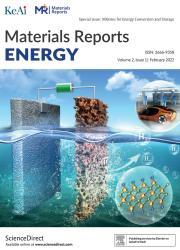A green route based on π-π interactions to coat graphite for high-rate and long-life anodes in lithium-ion batteries
IF 13.8
引用次数: 0
Abstract
Although graphite (G) materials dominate the commercial lithium-ion battery (LIBs) anode market due to their excellent overall performance, their limited rate performance and cycle life hinder applications in high-performance fields. To improve the cycling and rate performance of graphite anodes, this study first employed economical and eco-friendly tannic acid (TA) as a carbon coating precursor to coat graphite surfaces via π-π stacking interactions. In an oxygen-rich alkaline environment, tannic acid undergoes oxidation polymerization and crosslinks with formaldehyde to form a polymer matrix that coats the graphite surface. After subsequent carbonization, carbon-coated graphite material (G@C) was successfully synthesized. Carbon coatings on graphite effectively lower LIB resistance, enhance lithium-ion diffusion, and prevent exfoliation during cycling, thereby significantly boosting rate performance and prolonging the cycle life of graphite. After 500 cycles at 2C, the specific capacity of G@C was 103.7 mAh g−1, with a retention of 89%. However, G exhibited only 68.7 mAh g−1 and 85% retention under identical conditions. This carbon-coated graphite modification strategy offers a novel, green, and economical approach for designing and tailoring graphite anode materials for lithium-ion batteries with long cycle life and high rate.

基于π-π相互作用的绿色路线涂覆石墨,用于锂离子电池的高倍率和长寿命阳极
虽然石墨(G)材料由于其优异的整体性能在商用锂离子电池(LIBs)阳极市场占据主导地位,但其有限的倍率性能和循环寿命阻碍了其在高性能领域的应用。为了提高石墨阳极的循环性能和速率性能,本研究首先采用经济环保的单宁酸(TA)作为碳涂层前驱体,通过π-π堆叠相互作用涂覆石墨表面。在富氧的碱性环境中,单宁酸与甲醛发生氧化聚合和交联,形成覆盖石墨表面的聚合物基质。经后续碳化后,成功合成了碳包覆石墨材料(G@C)。石墨表面的碳涂层能有效降低锂离子放电阻力,增强锂离子扩散,防止循环过程中的脱落,从而显著提高石墨的倍率性能,延长石墨的循环寿命。在2C下循环500次后,G@C的比容量为103.7 mAh g−1,保持率为89%。而在相同条件下,G仅表现出68.7 mAh G−1和85%的保留率。这种碳包覆石墨改性策略为长循环寿命、高倍率锂离子电池石墨负极材料的设计和定制提供了一种新颖、绿色、经济的方法。
本文章由计算机程序翻译,如有差异,请以英文原文为准。
求助全文
约1分钟内获得全文
求助全文
来源期刊

材料导报:能源(英文)
Renewable Energy, Sustainability and the Environment, Nanotechnology
CiteScore
13.00
自引率
0.00%
发文量
0
审稿时长
50 days
 求助内容:
求助内容: 应助结果提醒方式:
应助结果提醒方式:


